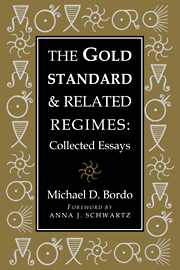Book contents
- Frontmatter
- Contents
- Foreword
- 1 The Gold Standard and Related Regimes: Introduction to the Collection
- Part I History of Doctrine and the Gold Standard
- Part II The Gold Standard as a Commodity Standard
- Part III The Gold Standard as a Contingent Rule
- Part IV Historical Case Studies
- Part V The Bretton Woods International Monetary System
- 12 The Bretton Woods International Monetary System: A Historical Overview
- 13 Is There a Good Case for a New Bretton Woods International Monetary System?
- Index
- Titles in the series
13 - Is There a Good Case for a New Bretton Woods International Monetary System?
Published online by Cambridge University Press: 19 October 2009
- Frontmatter
- Contents
- Foreword
- 1 The Gold Standard and Related Regimes: Introduction to the Collection
- Part I History of Doctrine and the Gold Standard
- Part II The Gold Standard as a Commodity Standard
- Part III The Gold Standard as a Contingent Rule
- Part IV Historical Case Studies
- Part V The Bretton Woods International Monetary System
- 12 The Bretton Woods International Monetary System: A Historical Overview
- 13 Is There a Good Case for a New Bretton Woods International Monetary System?
- Index
- Titles in the series
Summary
July 1994 marked the 50th anniversary of an historic international conference held at the Mount Washington Hotel in Bretton Woods, New Hampshire, that created the International Monetary Fund, the International Bank for Reconstruction and Development (World Bank), and the Bretton Woods adjustable-peg international monetary system, which prevailed from 1946 to 1973. Citing the problems of two decades of floating exchange rates (high transactions cost for business, excess volatility, and prolonged real misalignment of the exchange rates of major countries), many have used the occasion to call for a renewed role for the Bretton Woods institutions and a return to a more managed international monetary system based on principles similar to the Bretton Woods arrangements (Peter Kenen, 1994; Bretton Woods Commission, 1994). A more managed system based on coordinated monetary and fiscal policy and exchange-rate target zones, they argue, would revive the record of stable and rapid economic growth, low interest rates, and relatively low inflation of the original Bretton Woods era.
This chapter considers the validity of the case for a renewal of Bretton Woods based on an examination of its history, its macro performance, and its record as a credible commitment mechanism compared to that of other historical regimes.
The History of Bretton Woods
The Bretton Woods system faced a number of initial problems, and it took 12 years to achieve full operation in December 1958 when the Western European countries made their currencies convertible for current-account transactions.
- Type
- Chapter
- Information
- The Gold Standard and Related RegimesCollected Essays, pp. 501 - 512Publisher: Cambridge University PressPrint publication year: 1999
- 1
- Cited by

